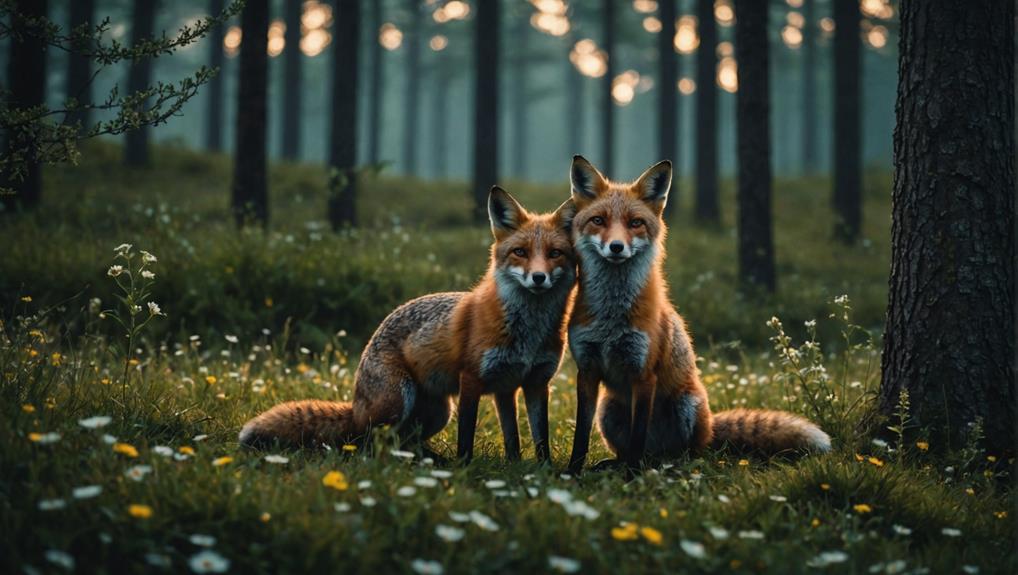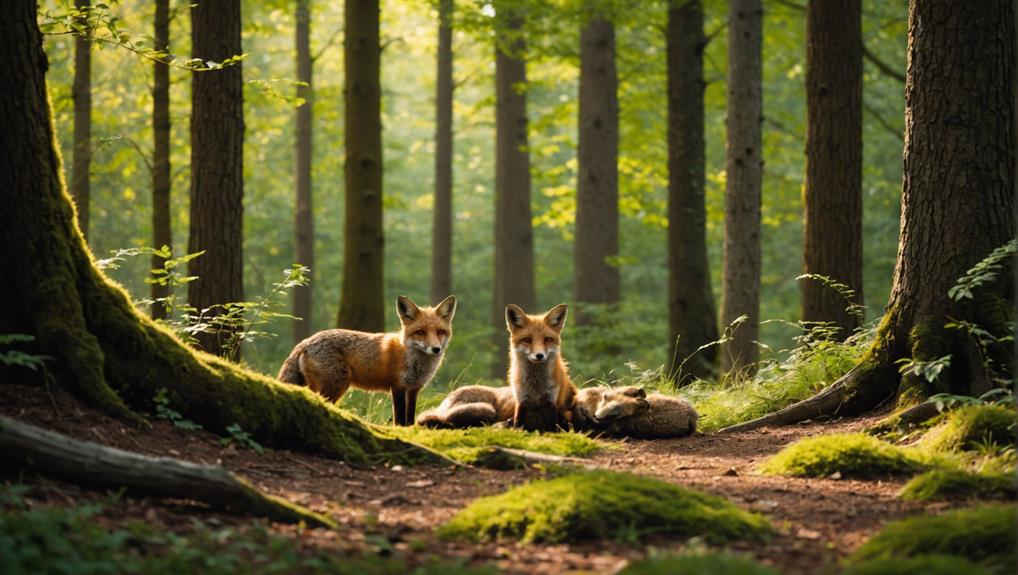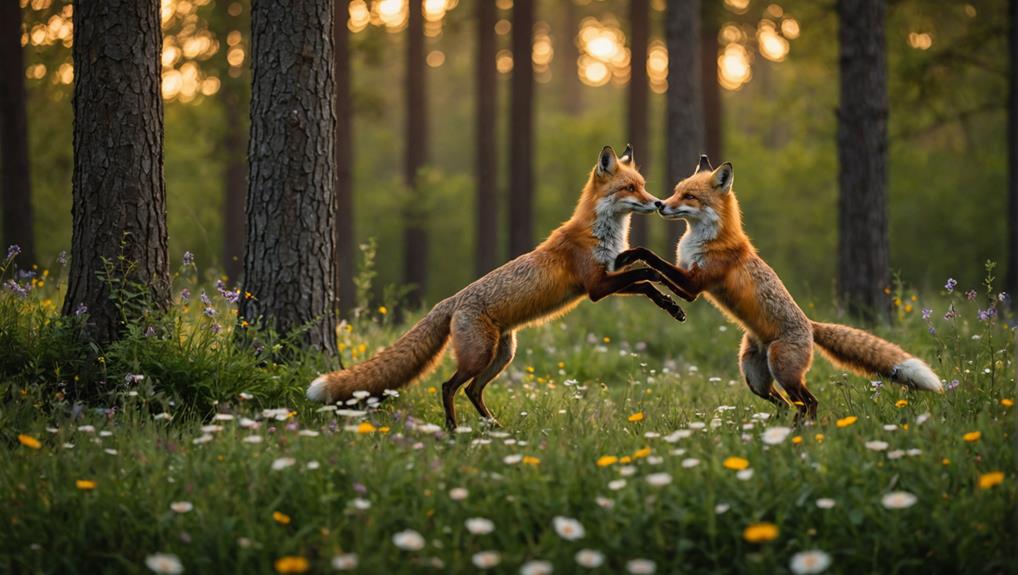When it comes to fox mating, you'll find that the average duration is about 26 minutes, but these passionate encounters can last up to 90 minutes! Imagine that—a romantic rendezvous in the wild! During copulation, a fascinating "copulatory tie" happens, where the male and female stay connected for safety and effectiveness. This brief but intense period is essential for successful mating since their breeding season is short. So, whether they're getting lovey-dovey or ensuring their future cubs, foxes sure know how to keep it exciting. Stick around to discover more about their intriguing life cycle!
Contents
Breeding Cycle Overview
Typically, red foxes start their breeding cycle around August, gearing up for mating between January and March when the female enters estrus. This is a captivating time for these clever creatures! The estrous cycle lasts about three weeks, with the real magic happening during the fertile phase, which can last from one to six days.
Curiously, each fox species showcases unique adaptations that may influence their breeding behaviors. Can you imagine the excitement?
As the mating season approaches, male foxes ramp up their game, with peak sperm production occurring in December and January. If all goes well, a successful mating can lead to a gestation period of 51 to 54 days.
During this time, the female might be dreaming of her future pups, with an average litter size of four to eight. That's a lot of little paws running around!
Even in urban environments, red foxes adapt to their surroundings, making the most of available resources. If a vixen doesn't mate, she might experience a nine-month anoestrus phase after a pseudo-pregnancy.
Copulation Duration
When red foxes mate, they engage in a fascinating process known as copulation, which usually lasts about 26 minutes on average. However, it can stretch up to 90 minutes in some cases! This duration is crucial for successful insemination during their brief breeding season.
Here are three key points to understand about copulation duration:
- Copulatory Tie: During mating, the male's bulbus glandis swells, creating a copulatory lock. This tie guarantees both partners stay connected, making it easier for the male to guard the female while she's less attentive.
- Vigilance: This lock allows the male to remain alert to potential threats, guaranteeing both partners stay safe during their intimate moment.
- Aggression: If the mating is interrupted, the male might display aggressive behaviors to defend his position, making it a serious affair!
Sperm Production Peaks

During the red fox's breeding season, sperm production peaks dramatically, ensuring that males are ready to fertilize a vixen's eggs at the right time. This peak typically occurs in December and January, aligning perfectly with the vixen's estrus phase.
You might be surprised to learn that at this time, the average ejaculate volume can range from 6 mL, containing over 300 million sperm, all the way up to a whopping 22 mL!
The sperm concentrations during peak production are impressive, too—between 200 and 500 million per ejaculate. That's comparable to human sperm counts! Curiously, around 88% of the sperm produced are normal, although some may have minor defects, often related to their tails. It's a bit like trying to swim when your legs aren't cooperating!
However, not all male foxes are created equal. Inexperienced males tend to have lower quality and quantity of sperm compared to their more seasoned counterparts.
Maternal Care After Mating
Maternal Care After Mating
After successful mating, the vixen's journey into motherhood begins as she prepares to give birth about 53 days later. She'll typically have a litter of four to five adorable cubs, who are born blind and totally dependent on her maternal care.
For the first two weeks, the vixen stays with them in the den, relying on the dog fox to bring food. This nurturing environment is essential for their survival, as both parents work together to guarantee the kits are well-fed and protected from potential threats, reflecting the significance of parental care in the wild!
It's a real team effort in the world of the Red Fox!
Here's what you can expect during this period of maternal care:
- Important Survival Skills: The vixen teaches her cubs how to hunt and interact socially, which is essential for their future.
- Social Learning: Non-breeding vixens might pitch in, helping to raise the cubs and boosting their chances of survival.
- Playful Development: Early interactions among the cubs are critical for establishing social hierarchies and behavior patterns, with playful tussles starting as early as four weeks old.
Urban foxes, just like their wild counterparts, engage in this nurturing process.
Cubs Development Timeline

Watching the development of fox cubs is a fascinating journey that unfolds quickly in their early weeks. When they're born, these adorable little ones are blind and covered in dark chocolate-brown fur. It takes about 10 to 14 days for their eyes to open, and oh, what a sight that is! The average litter size is around 4 to 5 cubs, and during the first two weeks, they rely entirely on their mother for warmth and nourishment.
Around 4 to 5 weeks old, you'll see them venture out of the den, and their fur starts shifting to that beautiful red hue we associate with foxes. This is an essential time for social interactions, as cubs begin to play, squabble, and establish their social hierarchy. You might even witness some playful aggression as they learn the ropes!
It's truly heartwarming to see them grow and interact. Each moment, from their first steps to their playful antics, reminds us of the beauty of life.
Environmental Influences on Mating
Environmental factors considerably shape the mating behaviors of red foxes. You mightn't realize it, but elements like day length and temperature can kick off their breeding season, which usually starts in January or early February.
Fox species exhibit fascinating adaptations that influence their reproductive strategies. The timing's essential since the estrous cycle of vixens lasts about three weeks, and they're only receptive for a brief period of 1-6 days.
Here are three key influences to take into account:
- Prey Availability: In areas with abundant food, vixens often have more opportunities to mate. This can lead to larger litters and better cub survival rates.
- Territorial Males: Dominant males often guard their territory fiercely. If they're around, lower-ranking males might struggle to access females, impacting mating success.
- Seasonal Changes: Did you know that sperm production peaks in December and January? This aligns perfectly with when females are ready to mate, ensuring the chances for successful reproduction.
Understanding these environmental conditions helps us appreciate the complexities of red fox mating behaviors. It's a wild world out there, isn't it?
Frequently Asked Questions
Why Do Female Foxes Scream During Mating?
When you observe female foxes screaming during mating, you'll notice these vocalizations enhance courtship displays, signal reproductive readiness, establish territory, and communicate stress responses, all essential for successful mating behaviors in their reproduction cycles.
How Long Do Female Foxes Stay in Heat?
During the breeding season, female foxes stay in heat for about 1 to 6 days. Their heat cycles, characterized by scent marking and reproductive behavior, influence mating frequency and eventually determine the gestation period.
What Is the Mating Ritual of Foxes?
You'll witness a wild spectacle during fox courtship! Their mating habits explode with vocal communication, as they mark territory and engage in enchanting pair bonding throughout the thrilling breeding season. It's nature's mesmerizing dance of love!
What Do Foxes Do After Their Mate Dies?
When a fox loses its mate, you'll notice changes in fox behavior. They enter a grieving process, adjust pack dynamics, mark territory fiercely, and may adopt solo living while reevaluating reproductive strategies for the future.
Final Thoughts
In the wild, fox mating is like a dance under the moonlight, full of rhythm and instinct. From the brief but intense copulation to the nurturing care of the mother, every step plays an essential role in the circle of life. These clever creatures adapt to their environment, ensuring their cubs thrive. So, next time you think of foxes, picture not just their playful antics, but the intricate journey of love and survival that unfolds quietly in nature.














